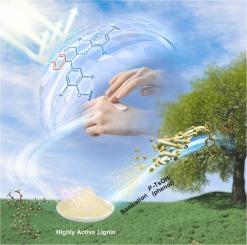亲核试剂与酸性亲水剂p-TsOH联合快速提取松木浅色木质素
IF 6.2
1区 农林科学
Q1 AGRICULTURAL ENGINEERING
引用次数: 0
摘要
木质素在分离过程中由于反应不可控而导致结构变化、反应活性降低、颜色加深是阻碍其有效利用的主要问题。采用亲核酚(PH)或丁香酚(SL)与疏水对甲苯磺酸(p-TsOH)结合的方法,在温和条件下从松木中分离出酚化的浅色木质素。结果表明,亲核PH或SL与侧链Cα位置的木质素的快速和靶向反应抑制了β-O-4键的裂解,从而减少了木质素的分子间缩聚和显色基团的形成。苯酚羟基的引入和较低的缩合度增强了木质素在对tsoh溶液中的溶解度,从而提高了木质素的提取率。分离得到的木质素颜色较浅,酚羟基和甲氧基较多,β-O-4键丰富,分子分布均匀,具有良好的紫外线屏蔽和抗氧化活性。通过抗溶剂法将酚化木质素容易自组装成规则的球形纳米颗粒,与面霜混合效果良好,可制备SPF值可调的防晒霜。本文章由计算机程序翻译,如有差异,请以英文原文为准。

Targeted phenolation and rapid extraction of light-colored lignin from pine using nucleophilic reagent in combination with acid hydrotrope p-TsOH
Structural change, reduced reactivity, and deepened color of lignin caused by uncontrollable reaction in the process of separation are the main problems that hinder its effective utilization. Based on lignin-first strategy, nucleophilic phenol (PH) or syringol (SL) in conjunction with hydrotrope p-toluenesulfonic acid (p-TsOH) was employed to separate phenolated and light-colored lignin from pine under mild conditions. It was found that the quick and targeted reaction of the nucleophilic PH or SL with lignin at the sidechain Cα position inhibited the cleavage of β-O-4 bonds thus reduced the intermolecular condensation of lignin and the formation of chromophoric groups. The introduction of phenolic hydroxyl groups and low condensation degree enhanced the solubility of lignin in p-TsOH solution, resulting in a high extract yield of lignin. The separated lignin had a lighter color, more phenolic hydroxyl and methoxyl groups, abundant β-O-4 bond and more uniform molecular distribution and exhibited an exceptional UV shielding and antioxidant activity. The phenolated lignins were easily self-assembled into regular spherical nanoparticles by anti-solvent method, which had good mixing effect with face cream to prepare sunscreen with adjustable sun protection factor (SPF) value.
求助全文
通过发布文献求助,成功后即可免费获取论文全文。
去求助
来源期刊

Industrial Crops and Products
农林科学-农业工程
CiteScore
9.50
自引率
8.50%
发文量
1518
审稿时长
43 days
期刊介绍:
Industrial Crops and Products is an International Journal publishing academic and industrial research on industrial (defined as non-food/non-feed) crops and products. Papers concern both crop-oriented and bio-based materials from crops-oriented research, and should be of interest to an international audience, hypothesis driven, and where comparisons are made statistics performed.
 求助内容:
求助内容: 应助结果提醒方式:
应助结果提醒方式:


